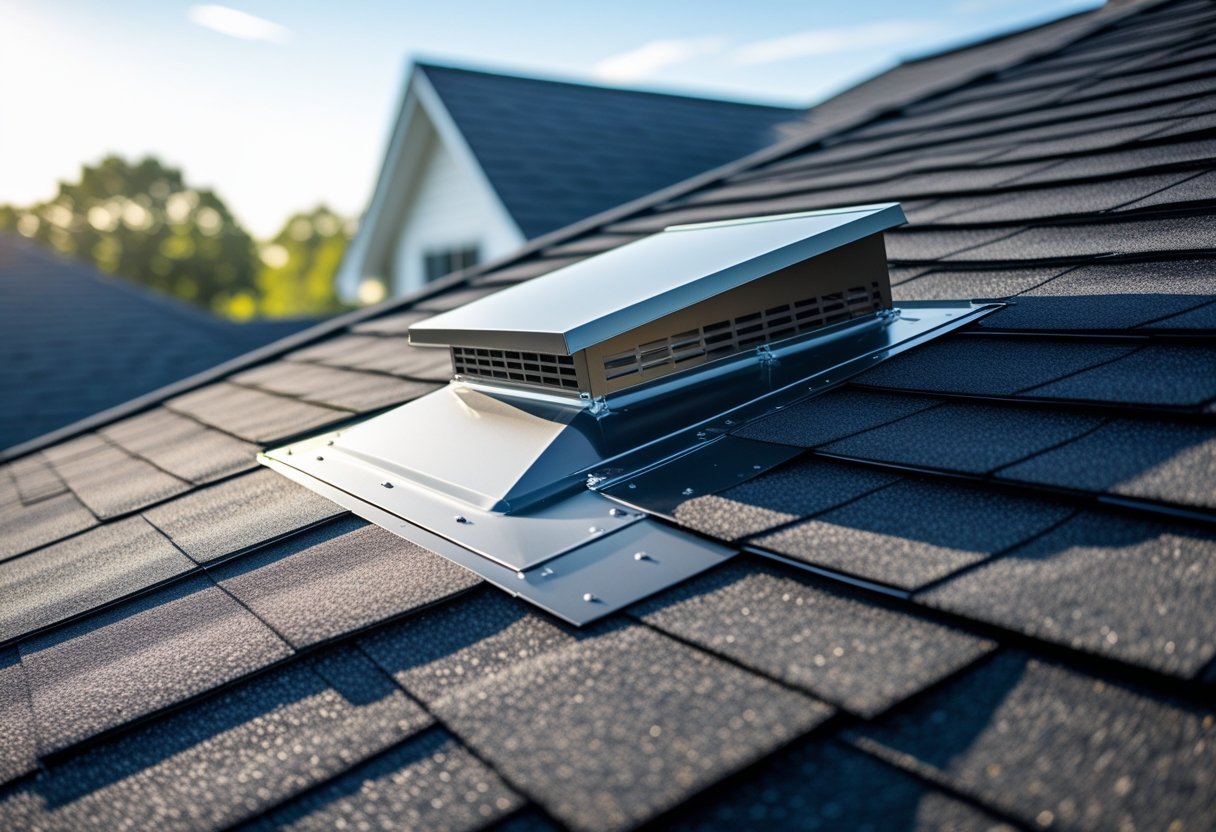Your home’s comfort really hinges on how well your roof can breathe. Proper roof ventilation keeps temperature and moisture in check, so your living spaces actually feel comfortable, no matter the season. When air moves through your attic the way it should, you’ll notice less heat piling up in summer and fewer moisture headaches when it’s cold out.
If your roof isn’t ventilated right, things get hot fast. That means higher energy bills and a house that just won’t cool down. Poor airflow also lets dampness creep in, leading to mold and damaged materials. At Clear Choice Roofing, we see every day how balanced roof ventilation can keep your home cozy and healthy.
You don’t have to play guessing games about airflow. Clear Choice Roofing can walk you through what proper ventilation looks like for your home and local codes. With the right setup, you’ll get a more comfortable, efficient house that’s protected from hidden damage.
Understanding Roof Ventilation
Roof ventilation keeps your attic air moving, which helps balance temperature and moisture. It relies on openings that let fresh air in and move hot, humid air out. This process protects your roof and makes your home feel better inside.
What Is Roof Ventilation
Roof ventilation is basically a system of vents that lets air travel through your attic. It clears out hot, moist air trapped under the roof, which otherwise would make your house hotter and damage your roofing.
You need both intake vents (usually by the eaves or soffits) and exhaust vents (up near the ridge or high spots). Keeping these balanced is key for steady airflow.
In Texas, the usual guideline is a net free vent area ratio of 1:150. So, for every 150 square feet of attic, you want 1 square foot of vent. This keeps things cooler and drier up there.
Types of Roof Ventilation Systems
There’s a few different vent types, each doing its part to keep air moving:
- Ridge Vents – run along the roof’s peak and let hot air out.
- Soffit Vents – sit under the eaves, bringing fresh air into the attic.
- Gable Vents – go on attic walls and can move air in or out, depending on the wind.
- Turbine Vents – spin with the wind to suck hot air out.
- Powered Vents – use electric fans to force air movement when nature’s not enough.
A good system mixes intake and exhaust vents for steady airflow.
How Roof Ventilation Works
Roof ventilation relies on natural air movement from heat and wind. Cooler air sneaks in through vents low on the roof—usually soffit or eave vents.
As the attic heats up, hot air rises and slips out through exhaust vents near the peak, like ridge vents. This flow stops heat from building up and keeps moisture from causing mold or rot.
When ventilation is balanced, your HVAC system doesn’t have to work so hard, which means lower energy bills and better comfort. Clear Choice Roofing can help you figure out the right setup to protect your house and keep it feeling good all year.
The Connection Between Roof Ventilation and Indoor Comfort
Solid roof ventilation keeps your home’s air fresher and temperatures steadier. It also helps cut down on moisture that makes things feel damp or causes damage. These factors combine to make your place a lot more comfortable.
Maintaining Consistent Indoor Temperatures
With proper roof ventilation, you get a better balance of hot and cool air. In Texas summers, hot air drifts up into the attic. Ventilation lets it escape, so you don’t end up with a heat trap under your roof.
In winter, ventilation keeps moisture in check and helps prevent ice dams by keeping your roof’s temperature more even. No more cold spots that lead to weird melting and refreezing.
When airflow is balanced, your HVAC doesn’t have to run overtime. You’ll notice more even temps throughout the house and lower energy bills—something Clear Choice Roofing always aims for.
Reducing Humidity Levels
Humidity stuck in your attic or roof space is trouble. It can trigger mold, rot wood, and leave your home smelling musty. Good ventilation sweeps damp air out and brings in dry air.
This keeps moisture from piling up, protects rafters and drywall, and helps your indoor air stay clean. Without enough airflow, humidity can make your home feel sticky or just plain uncomfortable. Cutting down on moisture makes your living spaces fresher. Clear Choice Roofing often suggests ventilation upgrades as part of roof maintenance to tackle these issues.
Minimizing Drafts and Stuffy Air
Poor ventilation lets air get stale, so rooms feel stuffy and odors hang around. When air can’t move, you might get drafts in some spots and trapped air in others.
A well-ventilated roof lets air move freely through the attic and ceilings. This helps stop hot or cold air pockets and balances temps between rooms.
You’ll probably notice fewer chilly drafts in winter and less trapped heat in summer. Fresh airflow also helps push out stale air and lower allergens.
All together, these perks make your home simply nicer to live in, whatever the weather.
Benefits of Improved Airflow in the Home
When air flows well, it’s easier to control temperature, moisture, and freshness. That means better comfort and fewer headaches from mold or allergens.
Enhancing Air Quality
Better airflow brings in fresh air and chases out the stale stuff. This keeps the air inside cleaner and just more pleasant. When air moves, odors fade faster and indoor pollution from dust, smoke, or cooking is less of a problem.
Attic ventilation matters here, too. It stops heat and humidity from building up near your roof, which keeps your whole house cooler and less stuffy. With fresher air, you might even feel less tired and breathe easier.
Preventing Mold and Mildew Growth
Trapped moisture inside leads to mold and mildew. These can wreck surfaces and mess with your health. When air moves like it should, it carries dampness away—especially from attics or crawl spaces. That means less mold on wood, drywall, and insulation.
Keeping moisture in check also protects your roof structure from rot. Clear Choice Roofing always highlights how good ventilation keeps homes dry and safe. Less moisture means fewer repairs and a healthier place to live.
Decreasing Allergens Indoors
When air’s not moving, allergens like dust mites, pollen, and pet dander just settle in. Better airflow pushes those irritants out and brings in fresh air.
If you or someone in your family deals with allergies or asthma, this makes a real difference. Good ventilation lowers the risk of flare-ups and just makes the home feel better. Pairing proper airflow with regular cleaning keeps allergens down and the air healthier.
Roof Ventilation’s Impact on Energy Efficiency
Roof ventilation does more for your energy bills than you might expect. It helps your HVAC run better and can extend its life, saving you money and hassle.
Lowering Heating and Cooling Costs
Ventilation clears hot air out of your attic in summer, stopping heat from seeping into your home. When the attic stays cooler, your AC doesn’t have to fight as hard. You could see cooling costs drop by up to 30%.
In winter, roof ventilation keeps moisture from getting trapped, so your insulation stays dry and works like it should. Dry insulation holds heat better, which helps keep heating bills down.
Using materials like metal roofing along with good ventilation can reflect heat, too. Clear Choice Roofing can help you find the right fit for your home and climate.
Preventing Overworked HVAC Systems
Without enough ventilation, your HVAC has to push harder to keep things comfortable. This wears the system out faster and drives up energy use. Over time, you’ll be dealing with more repairs or even early replacement.
With a ventilated attic, cooler air helps your system run smoother and more efficiently. That means less energy spent for the same comfort. Your HVAC will probably last longer, so you get more for your money.
Good airflow also keeps temperatures more even from room to room. Clear Choice Roofing can check your roof to make sure your ventilation’s actually working.
Protecting Your Home with Proper Roof Ventilation
Roof ventilation stops heat and moisture from piling up in your attic, helping you dodge problems that cost money and damage your place.
Extending Roof Lifespan
Your roof lasts longer with proper airflow. Ventilation lets hot air escape, so your attic stays cooler and roofing materials don’t break down as fast. Moisture is another big threat—without enough ventilation, it gets trapped, causing wood to rot or shingles to curl up. That’s a recipe for leaks and pricey repairs.
Keeping your roof dry and cool means fewer headaches down the line. Installing vents the right way, like Clear Choice Roofing recommends, protects your home in Texas’ heat and humidity.
Preventing Ice Dams in Winter
Ice dams happen when warm attic air melts snow on the roof, then the water refreezes near the eaves. This creates a dam that can push water under shingles and into your house. Proper ventilation keeps the attic cold by circulating outside air, so snow melts evenly and ice dams don’t form.
Ventilation works together with insulation to keep your roof’s temperature steady in winter. That way, you avoid damage from ice and leaks. Clear Choice Roofing can make sure your system’s up to the task all year.
Factors to Consider When Improving Roof Ventilation
When you’re looking at ventilation upgrades, consider your climate, roof design, and how the work gets done. These details help you choose what’ll actually work for your house.
Climate and Regional Needs
Your local climate really shapes what kind of ventilation you need. In Texas, for example, homes have to meet building codes like the International Residential Code (IRC) with specific vent ratios.
Hot, humid areas need ventilation that fights heat and moisture in the attic. That keeps your home cooler and stops mold. Colder places need ventilation to prevent ice dams and moisture issues.
Think about your local weather patterns, too. Good ventilation keeps your home cooler in summer and helps avoid winter damage. Clear Choice Roofing knows Texas weather and can help you pick the right setup.
Roof Design and Materials
The shape and materials of your roof affect how air moves. Steep roofs with open rafters might need vents in different spots than flat roofs. Materials like metal or tile act differently in the heat, so ventilation needs change, too.
Match your vents to your roof design for the best results. For example:
- Ridge vents are great for peaked roofs.
- Soffit vents bring in fresh air near the roof’s edge.
- Gable vents help with cross-ventilation, but usually aren’t enough by themselves.
Your roofing material also affects moisture control. Clear Choice Roofing uses materials that work with ventilation to guard against heat and humidity.
Professional Installation Benefits
Ventilation isn’t just about slapping a few vents on the roof. It takes planning and precision to meet codes and actually get results. A professional roofer can figure out the right vent sizes and place them where they’ll do the most good.
Bringing in pros like Clear Choice Roofing means you won’t deal with common mistakes like too little ventilation or blocked vents. They’ll also seal everything up so leaks aren’t a problem.
Getting it installed right boosts your home’s efficiency and comfort, protects your roof, and saves you repair money. Going with skilled contractors brings peace of mind and long-term benefits.
Common Mistakes to Avoid with Roof Ventilation
Getting roof ventilation right really matters for comfort and protection. If you install too much or too little, or put vents in the wrong places, you’ll run into airflow problems or even roof damage. Knowing what not to do helps keep your home in better shape and your living spaces more comfortable.
Insufficient or Excessive Ventilation
Not enough ventilation traps hot air and moisture in your attic. This bumps up indoor temps and can lead to mold or even wood rot. The International Residential Code recommends a balanced airflow—basically, you want a 1:150 ratio of vent area to attic space. So, if your attic is 150 square feet, you need at least 1 square foot of vent space, split between intake and exhaust vents.
But too much ventilation? That’s a problem, too. It can drag in cold air during winter, hiking up your heating bills. Sometimes, it’ll even pull away insulation heat unevenly. The trick is balance—enough venting to keep things dry and stable, but not so much that you’re fighting the weather.
Improper Placement of Vents
Where you install vents is just as important as how many you’ve got. Intake vents should sit down by the eaves or soffits, drawing in cooler air low to the ground. Exhaust vents work best up high—think roof ridge—so hot air can get out easily.
If vents cluster together or sit too close, airflow drops off fast. That leads to hot or damp patches, which can mess up your roof deck or insulation. And honestly, bad ventilation placement can even void your roofing warranty, especially if you skip professional help.
At Clear Choice Roofing, we pay close attention to vent placement and sizing. We want your home protected and comfortable, no matter the season.
Frequently Asked Questions
Good roof ventilation keeps temperatures steady, manages moisture, and supports your home’s air quality. It really shapes how comfortable your living space feels and how hard your heating and cooling systems have to work.
What role does roof ventilation play in regulating indoor temperatures?
Roof ventilation lets hot air escape from your attic. This keeps heat from building up inside your home—especially when summer’s doing its worst.
Lower attic temps mean cooler living spaces. Your air conditioning doesn’t have to work overtime, and your home just feels better.
Can improving attic ventilation impact overall home comfort levels?
Absolutely. Better attic ventilation spreads the temperature out more evenly. You don’t get those weird hot or cold spots.
So, your home feels more balanced and pleasant, year-round.
How does proper roof ventilation affect humidity control inside the house?
Good ventilation moves moist air out of your attic, which stops humidity from piling up indoors.
Lower humidity means less dampness—your home stays fresher.
Why is balanced attic ventilation crucial for maintaining a comfortable home environment?
Balanced ventilation brings in just the right amount of fresh air and lets out the right amount of stale air. That keeps heat and moisture in check.
If things get unbalanced, you might end up with chilly drafts in winter or trapped heat in summer. Not ideal for comfort.
How can roof ventilation contribute to reducing the risk of mold and mildew indoors?
When moist air leaves your attic, mold and mildew have a harder time taking hold. These problems thrive in damp, stuffy spaces.
By moving moisture out, roof ventilation helps protect your home’s structure—and your health, too.
In what ways does roof ventilation enhance the efficiency of HVAC systems?
Roof ventilation keeps attic temperatures and humidity down, so your heating and cooling systems don’t have to work overtime. That’s a win for your energy bills—and honestly, for the lifespan of your HVAC setup too.
If you’re thinking about tweaking your roof ventilation but aren’t sure where to start, expert help from Clear Choice Roofing might be worth a look. They’ve got some solid solutions.



